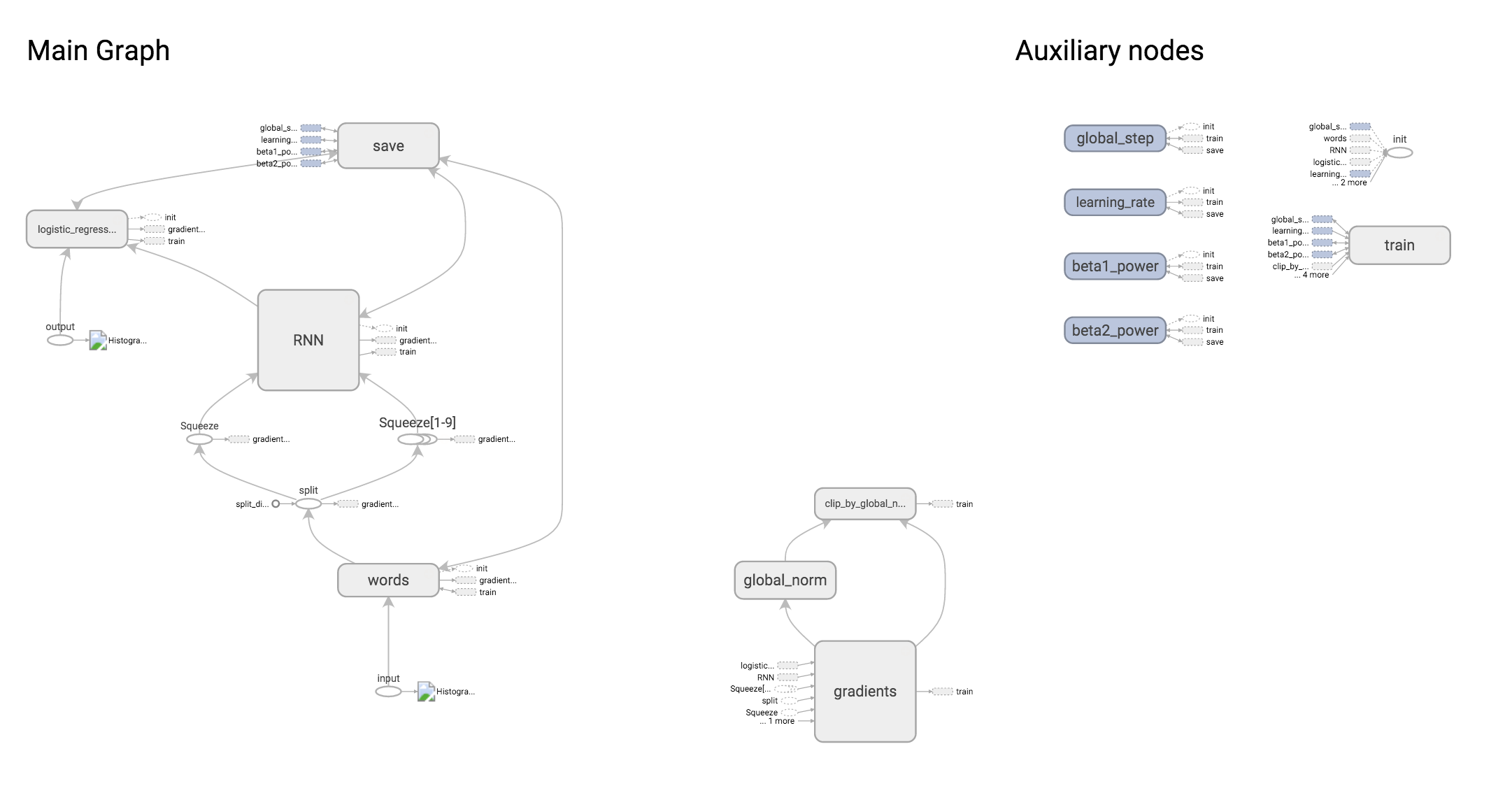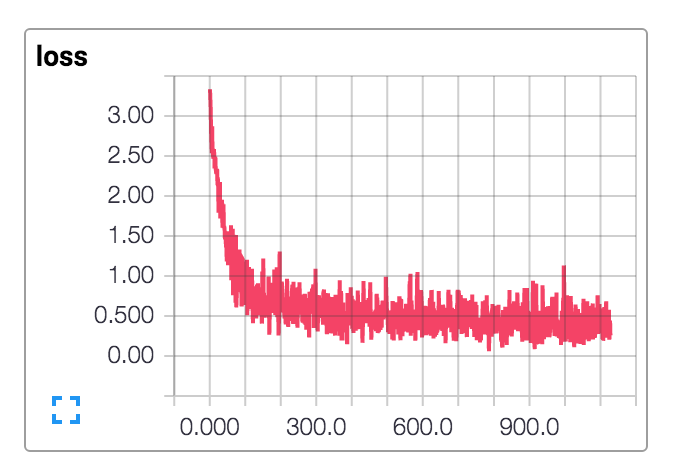1
2
3
4
5
6
7
8
9
10
11
12
13
14
15
16
17
18
19
20
21
22
23
24
25
26
27
28
29
30
31
32
33
34
35
36
37
38
39
40
41
42
43
44
45
46
47
48
49
50
51
52
53
54
55
56
57
58
59
60
61
62
63
64
65
66
67
68
69
70
71
72
73
74
75
76
77
78
79
80
81
82
83
84
85
86
87
88
89
90
91
92
93
94
95
96
97
98
99
100
101
102
103
104
105
106
107
108
109
110
111
112
113
114
115
116
117
118
119
120
121
122
123
124
125
126
127
128
129
130
131
132
133
134
135
136
137
138
139
140
141
142
143
144
145
146
147
148
149
150
151
152
153
154
155
156
157
158
159
160
161
162
163
164
165
166
167
168
169
170
171
172
173
174
175
176
177
178
179
180
181
182
183
184
185
186
187
188
189
190
191
192
193
194
195
196
197
198
199
200
201
202
203
204
205
206
207
208
209
210
211
212
213
214
215
216
217
218
219
220
221
222
223
224
225
226
227
228
229
230
231
232
233
234
235
236
237
238
239
240
241
242
243
244
245
246
247
|
# TF Learn
TF Learn is a simplified interface for TensorFlow, to get people started on predictive analytics and data mining. The library covers a variety of needs: from linear models to *Deep Learning* applications like text and image understanding.
### Why *TensorFlow*?
* TensorFlow provides a good backbone for building different shapes of machine learning applications.
* It will continue to evolve both in the distributed direction and as general pipelinining machinery.
### Why *TensorFlow Learn*?
- To smooth the transition from the [scikit-learn](http://scikit-learn.org/stable/) world of one-liner machine learning into the more open world of building different shapes of ML models. You can start by using [fit](https://www.tensorflow.org/api_docs/python/tf/contrib/learn/Estimator#fit)/[predict](https://www.tensorflow.org/api_docs/python/tf/contrib/learn/Estimator#predict) and slide into TensorFlow APIs as you are getting comfortable.
- To provide a set of reference models that will be easy to integrate with existing code.
## Installation
[Install TensorFlow](https://www.tensorflow.org/install/), and then simply import `learn` via `from tensorflow.contrib.learn` or use `tf.contrib.learn`.
Optionally you can install [scikit-learn](http://scikit-learn.org/stable/) and [pandas](http://pandas.pydata.org/) for additional functionality.
### Tutorials
- [TF Learn Quickstart](https://www.tensorflow.org/get_started/tflearn). Build,
train, and evaluate a neural network with just a few lines of code.
- [Input Functions](https://www.tensorflow.org/get_started/input_fn). Learn how
to create input functions to feed data into your models.
- [Linear Model](https://www.tensorflow.org/tutorials/wide). Learn the basics
of building linear models.
- [Wide and Deep Learning](https://www.tensorflow.org/tutorials/wide_and_deep).
Jointly train a linear model and a deep neural network.
- [Logging and Monitoring](https://www.tensorflow.org/get_started/monitors).
Use the Monitor API to audit training of a neural network.
- [Custom Estimators](https://www.tensorflow.org/extend/estimators). Learn
how to create a custom estimator.
- More coming soon.
### Community
- Twitter [#tensorflow](https://twitter.com/search?q=tensorflow&src=typd).
- StackOverflow with [tensorflow tag](http://stackoverflow.com/questions/tagged/tensorflow) for questions and struggles.
- GitHub [issues](https://github.com/tensorflow/tensorflow/issues) for technical discussions and feature requests.
### Existing Estimator Implementations
- [`LinearClassifier`](https://www.tensorflow.org/code/tensorflow/contrib/learn/python/learn/estimators/linear.py)
([docs](https://www.tensorflow.org/api_docs/python/tf/contrib/learn/LinearClassifier))
- [`LinearRegressor`](https://www.tensorflow.org/code/tensorflow/contrib/learn/python/learn/estimators/linear.py)
([docs](https://www.tensorflow.org/api_docs/python/tf/contrib/learn/LinearRegressor))
- [`DNNClassifier`](https://www.tensorflow.org/code/tensorflow/contrib/learn/python/learn/estimators/dnn.py)
([docs](https://www.tensorflow.org/api_docs/python/tf/contrib/learn/DNNClassifier))
- [`DNNRegressor`](https://www.tensorflow.org/code/tensorflow/contrib/learn/python/learn/estimators/dnn.py)
([docs](https://www.tensorflow.org/api_docs/python/tf/contrib/learn/DNNRegressor))
- [`DNNLinearCombinedClassifier`](https://www.tensorflow.org/code/tensorflow/contrib/learn/python/learn/estimators/dnn_linear_combined.py)
([docs](https://www.tensorflow.org/api_docs/python/tf/contrib/learn/DNNLinearCombinedClassifier))
- [`DNNLinearCombinedRegressor`](https://www.tensorflow.org/code/tensorflow/contrib/learn/python/learn/estimators/dnn_linear_combined.py)
([docs](https://www.tensorflow.org/api_docs/python/tf/contrib/learn/DNNLinearCombinedRegressor))
- [`SVM`](https://www.tensorflow.org/code/tensorflow/contrib/learn/python/learn/estimators/svm.py)
([docs](https://www.tensorflow.org/code/tensorflow/contrib/learn/python/learn/estimators/g3doc/svm.md))
- [`GMM`](https://www.tensorflow.org/code/tensorflow/contrib/factorization/python/ops/gmm.py)
([docs](https://www.tensorflow.org/code/tensorflow/contrib/factorization/g3doc/gmm.md))
- [`KMeansClustering`](https://www.tensorflow.org/code/tensorflow/contrib/learn/python/learn/estimators/kmeans.py)
([docs](https://www.tensorflow.org/code/tensorflow/contrib/factorization/g3doc/kmeans.md))
### Usage Examples
Below are a few simple examples of the API. For more examples, please see [examples](https://www.tensorflow.org/code/tensorflow/examples/learn).
General tips:
- It's useful to rescale a dataset to 0 mean and unit standard deviation before passing it to an [`Estimator`](https://www.tensorflow.org/api_docs/python/tf/contrib/learn/Estimator). [Stochastic Gradient Descent](https://en.wikipedia.org/wiki/Stochastic_gradient_descent) doesn't always do the right thing when variable are at very different scales.
- Categorical variables should be managed before passing input to the estimator.
## Linear Classifier
Simple linear classification:
```python
import tensorflow.contrib.learn.python.learn as learn
from sklearn import datasets, metrics
iris = datasets.load_iris()
feature_columns = learn.infer_real_valued_columns_from_input(iris.data)
classifier = learn.LinearClassifier(n_classes=3, feature_columns=feature_columns)
classifier.fit(iris.data, iris.target, steps=200, batch_size=32)
iris_predictions = list(classifier.predict(iris.data, as_iterable=True))
score = metrics.accuracy_score(iris.target, iris_predictions)
print("Accuracy: %f" % score)
```
## Linear Regressor
Simple linear regression:
```python
import tensorflow.contrib.learn.python.learn as learn
from sklearn import datasets, metrics, preprocessing
boston = datasets.load_boston()
x = preprocessing.StandardScaler().fit_transform(boston.data)
feature_columns = learn.infer_real_valued_columns_from_input(x)
regressor = learn.LinearRegressor(feature_columns=feature_columns)
regressor.fit(x, boston.target, steps=200, batch_size=32)
boston_predictions = list(regressor.predict(x, as_iterable=True))
score = metrics.mean_squared_error(boston_predictions, boston.target)
print ("MSE: %f" % score)
```
## Deep Neural Network
Example of 3 layer network with 10, 20 and 10 hidden units respectively:
```python
import tensorflow.contrib.learn.python.learn as learn
from sklearn import datasets, metrics
iris = datasets.load_iris()
feature_columns = learn.infer_real_valued_columns_from_input(iris.data)
classifier = learn.DNNClassifier(hidden_units=[10, 20, 10], n_classes=3, feature_columns=feature_columns)
classifier.fit(iris.data, iris.target, steps=200, batch_size=32)
iris_predictions = list(classifier.predict(iris.data, as_iterable=True))
score = metrics.accuracy_score(iris.target, iris_predictions)
print("Accuracy: %f" % score)
```
## Custom model
Example of how to pass a custom model to the Estimator:
```python
from sklearn import datasets
from sklearn import metrics
import tensorflow as tf
import tensorflow.contrib.layers.python.layers as layers
import tensorflow.contrib.learn.python.learn as learn
iris = datasets.load_iris()
def my_model(features, labels):
"""DNN with three hidden layers."""
# Convert the labels to a one-hot tensor of shape (length of features, 3) and
# with a on-value of 1 for each one-hot vector of length 3.
labels = tf.one_hot(labels, 3, 1, 0)
# Create three fully connected layers respectively of size 10, 20, and 10.
features = layers.stack(features, layers.fully_connected, [10, 20, 10])
# Create two tensors respectively for prediction and loss.
prediction, loss = (
tf.contrib.learn.models.logistic_regression(features, labels)
)
# Create a tensor for training op.
train_op = tf.contrib.layers.optimize_loss(
loss, tf.contrib.framework.get_global_step(), optimizer='Adagrad',
learning_rate=0.1)
return {'class': tf.argmax(prediction, 1), 'prob': prediction}, loss, train_op
classifier = learn.Estimator(model_fn=my_model)
classifier.fit(iris.data, iris.target, steps=1000)
y_predicted = [
p['class'] for p in classifier.predict(iris.data, as_iterable=True)]
score = metrics.accuracy_score(iris.target, y_predicted)
print('Accuracy: {0:f}'.format(score))
```
## Saving / Restoring models
Each estimator supports a `model_dir` argument, which takes a folder path where all model information will be saved:
```python
classifier = learn.DNNClassifier(..., model_dir="/tmp/my_model")
```
If you run multiple `fit` operations on the same `Estimator`, training will resume where the last operation left off, e.g.:
<pre><strong>classifier = learn.DNNClassifier(..., model_dir="/tmp/my_model")
classifier.fit(..., steps=300)</strong>
INFO:tensorflow:Create CheckpointSaverHook
INFO:tensorflow:loss = 2.40115, step = 1
INFO:tensorflow:Saving checkpoints for 1 into /tmp/leftoff/model.ckpt.
INFO:tensorflow:loss = 0.338706, step = 101
INFO:tensorflow:loss = 0.159414, step = 201
INFO:tensorflow:Saving checkpoints for 300 into /tmp/leftoff/model.ckpt.
INFO:tensorflow:Loss for final step: 0.0953846.
<strong>classifier.fit(..., steps=300)</strong>
INFO:tensorflow:Create CheckpointSaverHook
INFO:tensorflow:loss = 0.113173, step = 301
INFO:tensorflow:Saving checkpoints for 301 into /tmp/leftoff/model.ckpt.
INFO:tensorflow:loss = 0.175782, step = 401
INFO:tensorflow:loss = 0.119735, step = 501
INFO:tensorflow:Saving checkpoints for 600 into /tmp/leftoff/model.ckpt.
INFO:tensorflow:Loss for final step: 0.0518137.</pre>
To restore checkpoints to a new `Estimator`, just pass it the same `model_dir` argument, e.g.:
<pre><strong>classifier = learn.DNNClassifier(..., model_dir="/tmp/my_model")
classifier.fit(..., steps=300)</strong>
INFO:tensorflow:Create CheckpointSaverHook
INFO:tensorflow:loss = 1.16335, step = 1
INFO:tensorflow:Saving checkpoints for 1 into /tmp/leftoff/model.ckpt.
INFO:tensorflow:loss = 0.176995, step = 101
INFO:tensorflow:loss = 0.184573, step = 201
INFO:tensorflow:Saving checkpoints for 300 into /tmp/leftoff/model.ckpt.
INFO:tensorflow:Loss for final step: 0.0512496.
<strong>classifier2 = learn.DNNClassifier(..., model_dir="/tmp/my_model")
classifier2.fit(..., steps=300)</strong>
INFO:tensorflow:Create CheckpointSaverHook
INFO:tensorflow:loss = 0.0543797, step = 301
INFO:tensorflow:Saving checkpoints for 301 into /tmp/leftoff/model.ckpt.
INFO:tensorflow:loss = 0.101036, step = 401
INFO:tensorflow:loss = 0.137956, step = 501
INFO:tensorflow:Saving checkpoints for 600 into /tmp/leftoff/model.ckpt.
INFO:tensorflow:Loss for final step: 0.0162506.</pre>
## Summaries
If you supply a `model_dir` argument to your `Estimator`s, TensorFlow will write summaries for ``loss`` and histograms for variables in this directory. (You can also add custom summaries in your custom model function by calling [Summary](https://www.tensorflow.org/api_guides/python/summary) operations.)
To view the summaries in TensorBoard, run the following command, where `logdir` is the `model_dir` for your `Estimator`:
```shell
tensorboard --logdir=/tmp/tf_examples/my_model_1
```
and then load the reported URL.
**Graph visualization**

**Loss visualization**

## More examples
See the [examples folder](https://www.tensorflow.org/code/tensorflow/examples/learn) for:
- An easy way to handle [categorical variables](https://www.tensorflow.org/code/tensorflow/examples/learn/text_classification.py) (words are just an example of a categorical variable)
- Text Classification: see examples for [RNN](https://www.tensorflow.org/code/tensorflow/examples/learn/text_classification_character_rnn.py) and [CNN](https://www.tensorflow.org/code/tensorflow/examples/learn/text_classification_character_cnn.py) on characters
- [Digit recognition using a CNN](https://www.tensorflow.org/code/tensorflow/examples/learn/mnist.py)
- And much more!
|
